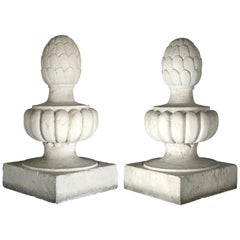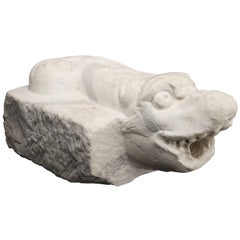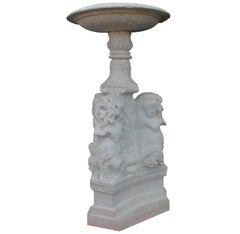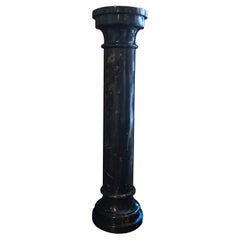SUBERT Building and Garden Elements
to
2
2
Height
to
Width
to
1
1
2
2
1
2
2
2
2
2
Italian Ancient Botticino Marble Pair of Pinnacles, circa 1850
Located in Milano, IT
Pair of pinnacles
Northern Italy, mid-19th century
Botticino marble, carved
They measure 33.1 inches in height x 17.7 x 17.7 (84 cm x 45 x 45)
State of conservation: some visible cracks and various small gaps.
The two twin architectural elements of sculpted Botticino marble have a quadrangular base from which a chalice-shaped foot extends. Resting on this, a round pod-like element swells up to support a large pine cone. This is the main decoration: however, the other ornamental details enhance and embellish it, while exalting its position above, whether observed from afar or up close.
These aesthetic characteristics suggest that originally the pair of pinnacles were placed on columns or on architectural plinths...
Category
Antique 1850s Italian Other Architectural Elements
Materials
Marble
Italian Ancient Marble Sculpture Fountain, Late 16th Century
Located in Milano, IT
Sea monster
Carrara marble mouth fountain
Italy, late 16th century
It measures 13.8 x 31.5 x 18.9 in (35 x 80 x 48 cm)
State of conservation: some small evident gaps and widespread signs of wear due to outdoor exposure. The gray marks crossing it do not come from restoration, but are rather the natural veins of the marble.
This work has some morphological characteristics typically associated with the iconography of the sea monster: an elongated muzzle, sharp teeth, protruding eyes, elongated ears, and a coiled serpent's tail.
An in-depth series of studies on artistic depictions of the sea monster attempted to verify how this symbol evolved in antiquity in the European and Mediterranean contexts and how it gradually changed its image and function over time. The iconography itself is mutable and imaginative and its history is rich with cultural and artistic exchange, as well as the overlapping of ideas. This occurred so much that it is difficult to accurately pinpoint the "types" that satisfactorily represent its various developments.
However, we can try to summarize the main figures, starting from the biblical Leviathan and the marine creature that swallowed Jonah (in the Christian version, this figure was to become a whale or a "big fish", the “ketos mega”, translation of the Hebrew “dag gadol”). Other specimens ranged from the dragons mentioned in the Iliad (which were winged and had legs) to "ketos” (also from Greek mythology), the terrifying being from whose Latinized name (“cetus”) derives the word "cetacean". See J. Boardman, “Very Like a Whale” - Classical Sea Monsters, in Monsters and Demons in the Ancient and Medieval Worlds, in Papers presented in Honor of Edith Porada, Mainz am Rhein 1987, pp. 73-84).
In Italy the monster underwent yet further variations: it can be found in Etruscan art on the front of some sarcophagi representing the companion of souls, while among the Romans we find the “Pistrice” (cited by Plinio in Naturalis Historia PLIN., Nat., II 9, 8 and by Virgilio in Eneide: VERG., Aen., III, 427), which appeared in the shape of a stylized hippocampus or a very large monstrous cetacean and evolved into a hideous being with a dragon's head and long webbed fins.
During the Middle Ages, the sea monster was the object of new transformations: at this time, it is often winged, the head is stretched like a crocodile, the front legs are often very sharp fins - sometimes real paws - until the image merges with dragons, the typical figures of medieval visionary spirituality widely found throughout Europe (on this topic and much more, see: Baltrušaitis, J., Il Medioevo fantastico. Antichità ed esotismi nell’arte gotica, Gli Adelphi 1997).
In Italy during the 15th and 16th centuries, the revival of classicism - representative of the humanistic and Renaissance periods - led to a different reading of these "creatures". Indeed, the sea monster was also to find widespread use as an isolated decorative motif, especially in numerous fountains and sculptures where dolphins or sea monsters were used as a characterizing element linked to water (on this theme see: Chet Van Duzer, Sea Monsters on Medieval and Renaissance Maps, London, The British library, 2013).
From the morphological point of view, the "sea monsters" of this period are mostly depicted as hybrid figures, in which the body of a mythological or real being (a hippocampus, a sea snake, a dolphin), is joined to a head with a rather indistinct appearance. It was usually characterized by large upright ears, an elongated snout, sharp teeth and globular, protruding eyes; a complex and indefinite figure, both from the symbolic point of view and from that of its genesis.
The work we are examining is placed as a cross between the medieval sea serpent and the Renaissance dolphin, with stylistic features which recall the snake as often used in heraldry (such as the "snake" depicted in the coat of arms of the Visconti - the lords and then dukes of Milan between 1277 and 1447 - and which, for some, may be derived from the representations of the “Pistrice” that swallowed Jonah).
In the search for sources, Renaissance cartography and in particular woodcuts should not be neglected. See for example the monsters of Olaus Magnus, from the editions of the “Historia de gentibus septentrionalibus” (“History of the peoples of the north”) and the natural histories of Conrad Gesner, Ulisse...
Category
Antique 16th Century Italian Renaissance Animal Sculptures
Materials
Carrara Marble
Related Items
Whimsical English 19th-20th Century White Marble Figural Outdoor Dog Fountain
Located in Los Angeles, CA
A Whimsical English 19th-20th century white marble figural fountain with dogs fountain. The Baroque Revival six-sided tripod marble base surmounted with three upright seated Yorkshire Terriers resting on a leaf and acanthus center stem, topped with a semi-circular scalloped carved basin...
Category
Antique Early 1900s English Baroque Revival Fountains
Materials
Marble
$14,850
H 60.63 in W 30.5 in D 28.5 in
French Black Marble Column
Located in Montreal, Quebec
French black marble column.
For a chic interior, classical lines in the spirit of Hollywood Regency.
Category
20th Century French Neoclassical Pedestals and Columns
Materials
Marble
Copper Mermaid Fountain by Glen Mayo
By Glen Mayo
Located in West Palm Beach, FL
Whimsical fountain sculpture, of copper, by metal artist Glen Mayo; its mermaid focal point holding a leaf which cascades water down the fountain, among turtles, angel fish, other se...
Category
1990s North American Fountains
Materials
Copper
Large 16th Century German Carved Basswood Saint Sebastian Sculpture
Located in London, GB
Antique Saint Sebastian Sculpture, Antique Saint Sebastian Statue, Antique Religious Sculpture, Religious Antique Sculpture, Antique Religious C...
Category
Antique 15th Century and Earlier German Renaissance Figurative Sculptures
Materials
Wood
$4,581
H 38.19 in W 9.26 in D 2.96 in
Wonderful Modernist Kenetic Motion Copper Fountain / Water Feature, Hand Made
Located in Buffalo, NY
Ingenious copper fountain / water feature, solid copper construction, Modernist design Artisan made, hand executed. Sculpture in motion, great for garden, or indoor space.
Category
Vintage 1970s American Mid-Century Modern Fountains
Materials
Copper
Architectural Studio Pottery Fountain by Piet Knepper
By Mobach, Piet Knepper
Located in London, GB
Fountain with two different tops by Piet Knepper for Mobach white glaze with copper oxide details and cracked surface, hand turned studio ceramic .
This is an example of Modern Scho...
Category
Vintage 1980s European Fountains
Materials
Ceramic
Pair of Marble Columns, Italy, Late 19th Century
Located in Roma, IT
Pair of Marble Columns is an impressive original decorative object probably realized in the 19th century (bases are much older).
Original very fine green marble and white marble (...
Category
Antique Late 19th Century Italian Pedestals and Columns
Materials
Marble, Carrara Marble
19th Century French Marble and Bronze Fountain
Located in Essex, MA
19th century French marble and bronze fountain. Seated satyr on marble column with marble shell basin. Later cast stone plinth. Wonderful garden ele...
Category
Antique Late 19th Century French Louis XV Figurative Sculptures
Materials
Marble, Bronze
Set of 4 Italian Rococo Painted Carved Columns
Located in Queens, NY
Set of 4 Italian Rococo (17th/18th Century) green painted columns with gold swirl carved floral design and Corinthian capitals.
Category
Antique Late 17th Century Italian Rococo Pedestals and Columns
Materials
Wood
Italian 19th-20th Century Whimsical White Marble Wishing Wellhead with Children
Located in Los Angeles, CA
A very fine and exceptionally carved Italian 19th-20th century Baroque Revival style whimsical white Carrara marble wishing wellhead, raised on an octagonal two-step marble base. The intricately carved marble relief circular wellhead depicting carved figures of dancing and cheerful children (Putti) among vines, flowers and fruits, dancing and playing musical instruments with a backdrop of castles, landscapes, forests and wreaths, Florence, circa, 1900.
Note: We have part II video of this amazing Wishing Wellhead. Please feel free to request a copy.
Literature:
A similar wellhead was sold by Jan's & Co. Fine French Antiques, Inc. in 1999, provenance the Atkinson/Kirkeby Estate and it is illustrated in "The Estates of Beverly Hills" by Charles Lockwood and Jeff-Hyland, page 150.
Another similar is currently on display at the gardens of "The Elms" mansion a public museum part of the Newport Mansions by The Preservation Society of Newport County in Newport, Rhode Island.
Yet another similar wellhead carved with frolicking putti with musical instruments and a dentil molded rim is located at Cranbrook House, Bloomfield Hills, Michigan, and is illustrated in B. Israel, Antique Garden Ornament...
Category
Antique Early 1900s Italian Baroque Revival Figurative Sculptures
Materials
Carrara Marble
$194,500
H 32 in Dm 51 in
Pair of Bronze and Brass Neoclassical Style Columns
Located in Delray Beach, FL
Exceptional pair of columns made of solid brass and cast bronze top , brass and bronze thickness
Is about 0.25 and because the heavy weight all parts of the columns are in inforce i...
Category
Antique Early 1900s American Architectural Elements
Materials
Steel, Brass, Bronze
$1,800 Sale Price / set
62% Off
H 45 in W 6 in D 6 in
English 19th Century Pair of Barley Twist Columns
Located in Baton Rouge, LA
This pair of English 19th century barley twist columns are a wonderful architectural antique to add an extra level of authenticity to your interior...
Category
Antique 19th Century English Other Pedestals and Columns
Materials
Wood, Hardwood



